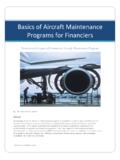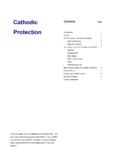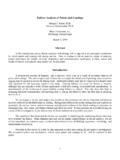Transcription of The Fundamentals of Asset Management - SIMPLE
1 The Fundamentals of Asset Management Executive Overview A Hands-On Approach Emerging utility business conditions z Increasing demand for utility services z Diminishing resources z Leveling of production efficiencies z Increasing restrictions on output z Aging infrastructure Result: increasingly expensive treatment options Fundamentals of Asset Management 2. Emerging utility business conditions z Aging customer base z Diminishing technical labor pool z Larger and more sophisticated facilities z Loss of knowledge with personnel retirements z Public resistance to rate increases Result: increasingly complex Management environment Fundamentals of Asset Management 3.
2 Changing utility business environment z Demand to do more with existing resources z Need to make every dollar work to better use capital and operating budgets z Move from reactive to proactive work environment Fundamentals of Asset Management 4. A paradigm shift . z Transition from building and operating to managing assets Extending Asset life Optimizing maintenance and renewal Developing accurate long-term funding strategies Sustain long term performance! Fundamentals of Asset Management 5. Infrastructure is the foundation to sustained quality of life Fundamentals of Asset Management 6. Consequences of Asset failure can be severe Fundamentals of Asset Management 7.
3 Asset Management improves . Decision making throughout the life cycle of the Asset z Acquisition z Operations z Maintenance z Renewal Resulting in lowest total cost of ownership Fundamentals of Asset Management 8. This training describes . z What is Asset Management ? z Why do it? z What deliverables do I get from it? z What are the steps? z How do I move my organization forward? Fundamentals of Asset Management 9. Views on Asset Management z Life cycle z Conceptual framework z Charter principles z Asset Management plan Fundamentals of Asset Management 10. What is Asset Management (AM)? z Systematic integration of advanced and sustainable Management techniques into a Management paradigm or way of thinking, with z Primary focus on the long-term life cycle of the Asset and its sustained performance, rather than on short- term, day-to-day aspects of the Asset Fundamentals of Asset Management 11.
4 Views on Asset Management a framework z Asset Management can be thought of as an object - a box or framework z Following is a brief characterization of 8. different views on Asset Management z These views make up the framework Fundamentals of Asset Management 12. View 1: Definition - Asset Management z Management paradigm and body of Management practices z Applied to the entire portfolio of infrastructure assets at all levels of the organization z Seeking to minimize total costs of acquiring, operating, maintaining, and renewing assets . z Within an environment of limited resources z While continuously delivering the service levels customers desire and regulators require z At an acceptable level of risk to the organization Fundamentals of Asset Management 13.
5 View 2: Life cycle business processes Plan Support processes Demand Management Knowledge of assets Dispose Acquire CIP validation Core Accounting & economics Condition & performance Processes monitoring Business risk exposure Renew Operate Works resource Management Review & continuous improvement Maintain Fundamentals of Asset Management 14. View 3: Core AM program elements Information Systems Lifecycle Data &. Process &. Knowledge Practices Total Asset Management Plan Organizational People Issues Issues Commercial Tactics Sustainable, best value service delivery Fundamentals of Asset Management 15.
6 View 4: Management framework Asset Management Business Processes Asset Management Plans Strategic Initiatives Annual Budgets Operating Budget Capital Budget Fundamentals of Asset Management 16. View 5: Five core questions 1. What is the current state of my assets? z What do I own? z Where is it? z What condition is it in? z What is its remaining useful life? z What is its remaining economic value? 2. What is my required level of service (LOS)? z What is the demand for my services by my stakeholders? z What do regulators require? z What is my actual performance? 3. Which assets are critical to sustained performance?
7 Z How does it fail? How can it fail? z What is the likelihood of failure? z What does it cost to repair? z What are the consequences of failure? 4. What are my best O&M and CIP investment strategies? z What alternative Management options exist? z Which are the most feasible for my organization? 5. What is my best long-term funding strategy? Fundamentals of Asset Management 17. View 6: AM plan 10-step process Determine Develop Assess Determine Set Target Live Cycle &. Asset Condition, Residual Levels of Replacement Registry Failure Modes Life Service (LOS). Costs Determine Optimize Optimize Determine Build AM.
8 Business Risk O&M Capital Funding Plan ( Criticality ) Investment Investment Strategy Fundamentals of Asset Management 18. View 6: AM plan 10-step process System Layout; Condition Demand Anal.;. Expected Life Data Hierarchy, Assessment Valuation; Life Balanced Tables;. Standards, and Protocol; Rating Cycle Costing Scorecard;. Decay Curves Inventory Methodologies Perform. Metrics Determine Develop Assess Determine Set Target Live Cycle &. Asset Condition, Residual Levels of Replacement Registry Failure Modes Life Service (LOS). Costs Determine Optimize Optimize Determine Build AM. Business Risk O&M Capital Funding Plan ( Criticality ) Investment Investment Strategy FMECA; Confidence Level Asset Mgmt Plan.
9 Root Cause;. Business Risk Rating; Strategic Renewal Policies and RCM; PdM;. Exp.; Delphi Validation; Annuity Strategy;. ORDM. Techniques ORDM Annual Budget Fundamentals of Asset Management 19. View 7: Seven principles of Asset Management 1. The Value Added/Level of Service Principle assets exist to deliver services and goods that are valued by the customer-stakeholder; for each consumer-stakeholder there is a minimum level of service below which a given service is not perceived as adding value. 2. The Life Cycle Principle all assets pass through a discernable life cycle, the understanding of which enhances appropriate Management .
10 3. The Failure Principle usage and the operating environment work to break-down all assets; failure occurs when an Asset can not do what is required by the user in its operating environment. 4. The Failure Modes Principle not all assets fail in the same way. 5. The Probability Principle not all assets fail at the same time. 6. The Consequence Principle not all failures have the same consequences. 7. The Total Cost of Ownership Principle there exists a minimum optimal investment over the life cycle of an Asset that best balances performance and cost given a target level of service and a designated level of risk.








